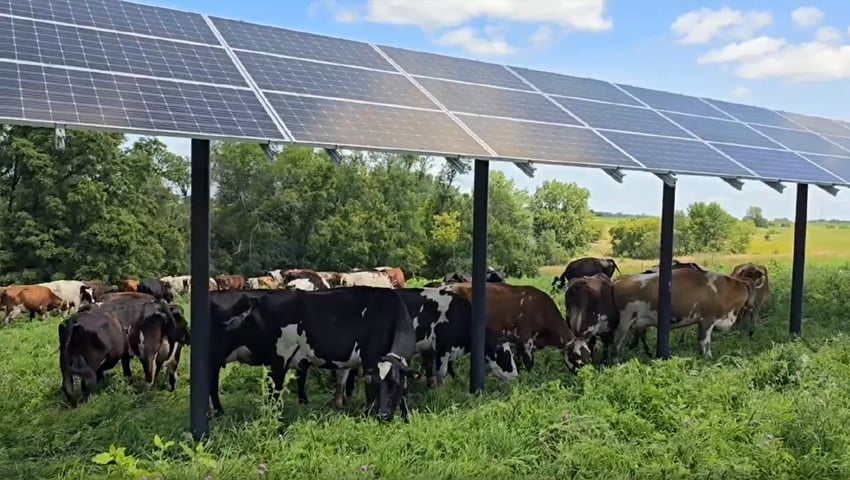Extracts from an Insight article by BE&R, an Australian-based energy consultancy
The global push for renewable energy to replace fossil fuels has increased competition for land use. The demand for land has met with increased opposition from the agricultural industry, which is charged with feeding our growing population with ever-reducing areas of arable land.
Agriphotovoltaic (APV) systems, also known as agrivoltaic systems, integrate solar energy production with agricultural production, offering a potential solution to the land use problem by combining energy generation with food cultivation.
The core concept of agrivoltaics is to optimise land use efficiency and productivity. Leveraging the same land for both solar energy production and agriculture addresses competing land use challenges and offers numerous benefits, such as:
- Enhanced crop productivity – Agrivoltaics improves land productivity by providing shade to crops, reducing evaporation, and decreasing water requirements. This is particularly advantageous in arid and semi-arid regions with limited water resources. The panels act as a protective canopy, moderating temperature extremes and acting as a windshield to enhance crop yields.
- Clean energy generation – Solar panels in agrivoltaic systems produce clean, renewable energy, contributing to the overall energy supply. This reduces greenhouse gas emissions and decreases dependence on fossil fuels.
- Economic benefits – Agrivoltaics offers additional income streams to farmers through the leasing of land for the agrivoltaic systems or enabling them to generate electricity themselves and sell it back to the grid. It also lowers direct energy costs for farmers, increasing the financial sustainability of their operations.
- Land preservation – Utilising the same land for agriculture and solar energy production helps preserve agricultural land that may otherwise be converted for solar installations or urban development. It also aids in biodiversity preservation.
While agrivoltaics presents numerous advantages, there are challenges to address. Careful planning is required to design and manage agrivoltaic systems to ensure optimal plant growth, resource use efficiency, solar panel maintenance, selection of crops suitable for the shaded conditions and evaluation of the economic viability of the combined system.
These benefits must of course be set against constraints, such as the high initial installation costs, ongoing maintenance expenses, and a small amount of agricultural land loss.
Agrivoltaics operate by merging solar panels with agricultural methods to maximise the advantages of both systems. It’s important to consider:
- Site selection – Suitable locations for agrivoltaic systems are identified based on land availability, solar resource potential, soil quality, and proximity to existing grid infrastructure.
- Solar panel installation – Solar panels are installed above or alongside agricultural fields, mounted on structures like poles, frames, or racks, or integrated into existing agricultural infrastructure such as greenhouses or shade structures.
- Design considerations – Various factors such as panel tilt angle, height, spacing, and orientation are considered in the design of agrivoltaic systems. These factors are optimised to balance maximising solar energy generation while minimising shading impacts on crop growth.
- Crop selection – Crops suited for agrivoltaic systems are chosen based on their capacity to tolerate or benefit from the shading provided by the solar panels. Leafy greens, herbs, and shade-tolerant plants thrive in these systems.
- Livestock selection – Sheep are frequently integrated with solar arrays, but larger livestock can also benefit from the shade provided by the panels, especially in pasture landscapes with few trees. Farmers are increasingly experimenting with integrating a range of livestock and poultry.
- Shading and microclimate effects – Solar panels shade the crops, reducing excessive sunlight and moderating temperature extremes. This promotes a favourable microclimate for crop growth, enhancing water efficiency and reducing evaporation.
- Resource management – Irrigation, nutrient management, and pest control practices are adjusted to accommodate the shading effects and altered microclimate in agrivoltaic systems. Water use may decrease due to the shading effect, necessitating careful monitoring and management for optimal crop growth.
- Energy generation and management – The solar panels produce electricity, which can be utilised on-site to power agricultural operations and fed into the grid for distribution.
- Maintenance and monitoring – Regular maintenance of the solar panels is crucial to ensure optimal energy generation. Monitoring systems are commonly employed to track the solar panels’ performance and crop growth, enabling adjustments as necessary.
Agrivoltaic systems can be adapted to various agricultural practices, including row crops, orchards, vineyards, and greenhouse cultivation. Design and management techniques may vary based on climate, crop type, and regional conditions.
Challenges and Opportunities in Agrivoltaics
Co-locating agricultural and energy systems offers farmers, solar developers, and governments a promising path but requires careful planning and integration.
The adoption of agrivoltaic systems has been gradual due to technical knowledge gaps, economic hurdles, inadequate planning, and inconsistent policy guidance.
To facilitate the widespread adoption of agrivoltaics, there is a need to address restrictive insurance requirements, leverage the power distribution network to benefit horticultural regions, increase the planning of solar grazing/crop systems, prioritise biodiversity in low rainfall zones, and establish user-friendly best practice guidelines.
Government policy and incentives will play an important role in successfully implementing agrivoltaics.
Image from video by Brad Heins, Professor at University of Minnesota
Read the original article with references to the situation in Australia
